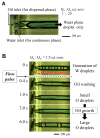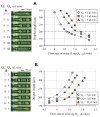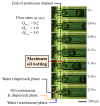Structural Formation of Oil-in-Water (O/W) and Water-in-Oil-in-Water (W/O/W) Droplets in PDMS Device Using Protrusion Channel without Hydrophilic Surface Treatment
- PMID: 30424401
- PMCID: PMC6187530
- DOI: 10.3390/mi9090468
Structural Formation of Oil-in-Water (O/W) and Water-in-Oil-in-Water (W/O/W) Droplets in PDMS Device Using Protrusion Channel without Hydrophilic Surface Treatment
Abstract
This paper presents a simple method of droplet formation using liquids that easily wet polydimethylsiloxane (PDMS) surfaces without any surface treatment. Using only structural features and uniform flow focusing, Oil-in-Water (O/W) and Water-in-Oil-in-Water (W/O/W) droplets were formed in the full PDMS structure. Extrusion channel and three-dimensional flow focusing resulted in effective fluidic conditions for droplet formation and the droplet size could be precisely controlled by controlling the flow rate of each phase. The proposed structure can be utilized as an important element for droplet based research, as well as a droplet generator.
Keywords: double emulsion; microdroplet; polydimethylsiloxane; three-dimensional structure.
Conflict of interest statement
The authors declare no conflict of interest. The funders had no role in the design of the study; in the collection, analyses, or interpretation of data; in the writing of the manuscript, or in the decision to publish the results.
Figures








Similar articles
-
In-Channel Responsive Surface Wettability for Reversible and Multiform Emulsion Droplet Preparation and Applications.ACS Appl Mater Interfaces. 2019 May 8;11(18):16934-16943. doi: 10.1021/acsami.9b03160. Epub 2019 Apr 24. ACS Appl Mater Interfaces. 2019. PMID: 30983312
-
Simple One-Step and Rapid Patterning of PDMS Microfluidic Device Wettability for PDMS Shell Production.Front Bioeng Biotechnol. 2022 Apr 19;10:891213. doi: 10.3389/fbioe.2022.891213. eCollection 2022. Front Bioeng Biotechnol. 2022. PMID: 35519623 Free PMC article.
-
Formation of double emulsion micro-droplets in a microfluidic device using a partially hydrophilic-hydrophobic surface.RSC Adv. 2021 Nov 3;11(56):35653-35662. doi: 10.1039/d1ra06887c. eCollection 2021 Oct 28. RSC Adv. 2021. PMID: 35493190 Free PMC article.
-
Microfluidic preparation of water-in-oil-in-water emulsions with an ultra-thin oil phase layer.Lab Chip. 2010 Feb 7;10(3):357-62. doi: 10.1039/b916318b. Epub 2009 Nov 26. Lab Chip. 2010. PMID: 20091008
-
Droplet flow cytometry for single-cell analysis.RSC Adv. 2021 Jun 14;11(34):20944-20960. doi: 10.1039/d1ra02636d. eCollection 2021 Jun 9. RSC Adv. 2021. PMID: 35479393 Free PMC article. Review.
Cited by
-
Light-Responsive Materials in Droplet Manipulation for Biochemical Applications.Adv Mater. 2025 Jan;37(2):e2313935. doi: 10.1002/adma.202313935. Epub 2024 Mar 1. Adv Mater. 2025. PMID: 38379512 Free PMC article. Review.
-
Integration of Horizontal and Vertical Microfluidic Modules for Core-Shell Droplet Generation and Chemical Application.Micromachines (Basel). 2019 Sep 15;10(9):613. doi: 10.3390/mi10090613. Micromachines (Basel). 2019. PMID: 31540177 Free PMC article.
References
-
- Chou W.-L., Lee P.-Y., Yang C.-L., Huang W.-Y., Lin Y.-S. Recent advances in applications of droplet microfluidics. Micromachines. 2015;6:1249–1271. doi: 10.3390/mi6091249. - DOI
Grants and funding
LinkOut - more resources
Full Text Sources

